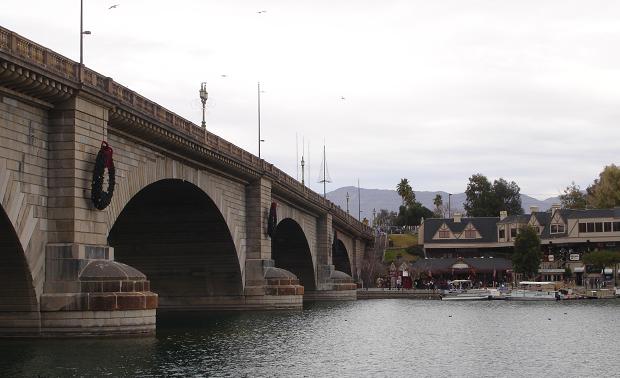Below – still no pictures from today, so I used some old ones. The first is Vienna from my 2006 visit there and the second is London Bridge, moved some years ago to Lake Havasu, Arizona from 2005.

Our leadership seminar continued along the lines of process, not content. We learn that we should have vision and that we should be collaborative with others. I am not sure that is always the best idea. IMO the most important thing about a vision is that it be right and that is not always what most people see clearly. Good leaders can often see that better than most others. That is one of the traits of good leadership. I don’t think you can assess leadership properly if you accept that it could be content neutral. We have to judge by where leadership is leading and how it is working. I am learning more from my colleagues than from the course. This is the way it often works. One of my colleagues gave the example of the “Music Man.” The guy in the movie (Robert Preston) has vision, but in order to get buy in from the satisfied citizens of River City he has to create an artificial problem that only he can solve. Con-men can create compelling visions. In fact that is one of their peculiar talents. Many “leaders” paint an inaccurately depressing picture of current events so that they can create support for their proposed solutions. Honest decision makers know that it is very important accurately to assess where you are before you decide where you want to go. The saying is “describe before you prescribe.”
If you can make a bad vision popular with scam tactics (as in the “Music Man,”) it is also true that good leadership and vision may be unpopular. Even the best plans don’t sell themselves and you may not get “buy in” from majorities or even large numbers of people despite the fact that the end result may be good or necessary. Change is usually perceived as risky and often painful. It may make people openly hostile, but that is why we need leadership. Leadership means setting priorities and making the tough choices. Leadership is not required if conditions are stable and decisions are trivial or within routine norms; that is just administration. You cannot be a leader by merely following the long-stated preferences and routine procedures of the groups you ostensibly lead and you cannot lead from behind. My criticism of the leadership course is that the instructors seem uncomfortable with the harder, less popular and maybe the tough parts of leadership.
I agree with the emphasis of the instructors of putting people first and trying to get cooperation, but that good bias can be taken too far. As one of my colleagues pointed out, leadership must sometimes put the mission before particular people. People are willing to sacrifice for a good cause and sometimes they have to do that. I don’t think we talked enough about those situations and we don’t talk enough about the sometimes scary and lonely decisions leaders must make.
All the people of the past who we consider great leaders took decisions that were deeply unpopular at the time. It is only with the fullness of time that we have come around to seeing the wisdom of their choices. As someone who is interested in history, I wish we had more historical examples in the course. Our course is being held not far from Antietam that back in September 1862 saw the bloodiest single day in American history. That is a classic case study in the results of poor and timid decisions contrasted with bold ones. McClellan had twice as many men as Lee and he had captured Lee’s battle plan, yet he still managed to produce only an inconclusive stalemate. I think it would be useful to consider that George McClellan was very popular with both his troops and the public. His decisions were broadly popular and particularly wrong. On the other hand, Lincoln’s decisions almost cost him the election in 1864 AND that was considering votes only with the half of the country that had not taken up arms against his leadership (a fairly good measure of disagreement). An opinion poll that included the whole country certainly would have given him a very low approval rating.

One highlight of the day was when three of my colleagues formed a panel to discuss transformational diplomacy. They had been talking about it in a side discussion and shared it because it was of general interest. (Such things excite us. I guess we are indeed a pack of nerds.) Most of us agreed that the ideas behind transformational diplomacy were good, but our class was divided about the efficacy of the program. Some of the places that got resources had trouble absorbing them and the places that lost them suffered painful cuts. It would have been better to ask for additional resources rather than just move priorities. We all agreed that places like India, Brazil & China deserved more resources and diplomatic attention, but it was not a good idea to take them away from places like Germany, Spain or France, which are still very important places that matter to us even if they are pleasant, peaceful and familiar.
One of my colleagues speculated about how the events around the Iraq war might have unfolded differently if we had sufficient diplomatic infrastructure on the ground in Germany & France to carry out strong public relations and diplomatic programs. This was BEFORE the diplomatic transformation, but we had already lost a lot to the cuts of the 1990s and the movement of resources to the new states of the former Soviet Union. You can only do so much with less. We opened and staffed post in places like Kazakhstan, Latvia, Armenia and Azerbaijan w/o a bump up in resources. I am convinced that we had significant problems with public diplomacy after 9/11 because our public diplomacy infrastructure was so decimated in the 1990s and spread too thin. I wrote re that in an earlier post and won’t repeat it here. Anyway, it was an interesting discussion.
My colleagues made some comments worth writing down. One said that vision means a leap beyond where you are – a leap of faith because it usually represents discontinuous change, not very catchy, but true. The best line of the day was, “if you ask for infinity, you can easily settle for half of infinity.”
